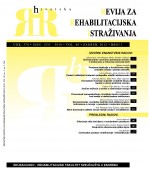UČESTALOST I FUNKCIJE MAJČINIH VERBALNIH ISKAZA
I GESTA U RANOM JEZIČNOM RAZVOJU
FREQUENCY AND FUNCTIONS OF MOTHERS' VERBAL RESPONSES AND GESTURES IN EARLY LANGUAGE
DEVELOPMENT
Author(s): Antonija Maričić, Maja Kelić, Maja CepanecSubject(s): Education, Language acquisition, Theory of Communication
Published by: Sveučilište u Zagrebu, Edukacijsko-rehabilitacijski fakultet
Keywords: interaction; communication; gestures; prelinguisticperiod; mother-child; functions of verbal responses;
Summary/Abstract: Communication between adults differs from adult-child communication in a number offeatures. Characteristics of motherese (child-directed speech) are well described in the literature, but less is known about adaptations adults make in other communication features. In this study we analyzed video-tapes of communication in 10 mother-childpairs. Frequencies of gestures (as well as relationship between gestures and verbal responses) and frequencies of various functions of verbal utterances were observed. These features were analyzed in children aged, on average, 13 months, e.g. in children who were starting with first words expression. Results show that mothers used gestures in about 15 % of responses. This data infer that parents use less gestures when communication with their children than with other adults. When parent used gestures, in almost 80% they used deictic gestures, while they used iconic and conventional gestures with a lower frequency. The most frequent functions of verbal utterances were: commands/warnings, decriptions, drawing attention and naming objects and people. Parent most often used gestures with verbal utterances that served as attention devices. In that way, they, intuitively, give additional support of language acquistion in children whose joint attention skills are still immature.
Journal: Hrvatska revija za rehabilitacijska istraživanja
- Issue Year: 48/2012
- Issue No: 1
- Page Range: 44-54
- Page Count: 11
- Language: Croatian

